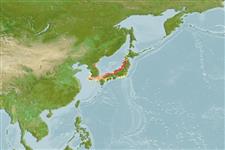Environment: milieu / climate zone / depth range / distribution range
Écologie
marin; eau douce; saumâtre démersal; anadrome (Ref. 51243). Temperate; 56°N - 33°N, 125°E - 145°E (Ref. 54262)
Northwest Pacific: Bering Sea, Tumnin (Datta) river, to northern Japan and Korea. This species was formerly regarded to be a population of Acipenser medirostris (Ref. 6866).
Taille / Poids / Âge
Maturity: Lm ? range ? - ? cm
Max length : 150 cm TL mâle / non sexé; (Ref. 12218)
Épines dorsales (Total) : 0; Rayons mous dorsaux (Total) : 33 - 40; Épines anales: 0; Rayons mous anaux: 22 - 30. Body shields in 5 rows; dorsal shields 7 to 11, lateral 22 to 36 and ventral 10.
Commercially cultured in Japan (Ref. 6866). From April to May adults feed in fresh water and return to the ocean during the fall (Ref. 12218). Generation time: 15 years (Ref. 116373).
Life cycle and mating behavior
Maturities | Reproduction | Spawnings | Egg(s) | Fecundities | Larves
Eggs are laid from April to August under the substrate in sandy areas (Ref. 12218).
Birstein, V.J., 1993. Sturgeons and paddlefishes: threatened fishes in need of conservation. Conserv. Biol. 7:773-787. (Ref. 6866)
Statut dans la liste rouge de l'IUCN (Ref. 130435)
Menace pour l'homme
Harmless
Utilisations par l'homme
Pêcheries: intérêt commercial mineur; Aquaculture: commercial
Outils
Articles particuliers
Télécharger en XML
Sources Internet
Estimates based on models
Preferred temperature (Ref.
123201): 13.6 - 20.1, mean 18.3 °C (based on 34 cells).
Phylogenetic diversity index (Ref.
82804): PD
50 = 0.5000 [Uniqueness, from 0.5 = low to 2.0 = high].
Bayesian length-weight: a=0.00324 (0.00142 - 0.00736), b=3.17 (2.99 - 3.35), in cm total length, based on LWR estimates for this Genus-body shape (Ref.
93245).
Niveau trophique (Ref.
69278): 3.3 ±0.3 se; based on size and trophs of closest relatives
Résilience (Ref.
120179): Très faible, temps minimum de doublement de population supérieur à 14 ans (Preliminary K or Fecundity.).
Fishing Vulnerability (Ref.
59153): Very high vulnerability (90 of 100).
